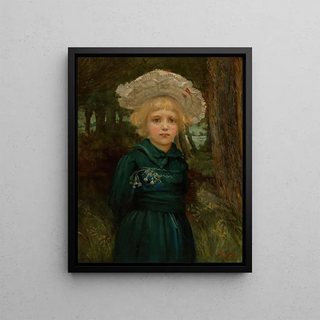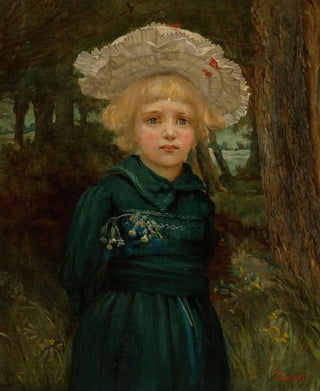Art print | Portrait of a girl in a green dress - Hans Thoma


View from behind

Frame (optional)
In the rich and diverse universe of art, some works stand out for their ability to capture the very essence of humanity. "Portrait of a girl in a green dress" by Hans Thoma is one of these iconic pieces. This painting, which evokes both tenderness and melancholy, immerses us in a world where childhood beauty blends with an atmosphere filled with mystery. The girl, dressed in her green dress, seems to observe us with innocent curiosity, while the blurred and delicate background enhances the intensity of her gaze. This portrait, beyond its simple appearance, is an invitation to contemplation, an exploration of human emotions through the lens of art.
Style and uniqueness of the work
Hans Thoma's style is characterized by a harmonious fusion of realism and impressionism. In "Portrait of a girl in a green dress," the artist manages to create an atmosphere that is both intimate and universal. The vibrant colors, especially the green of the dress, are carefully chosen to evoke freshness and vitality of childhood. Thoma uses delicate brushstrokes that bring life to the texture of the clothing and the softness of the child's skin. The light, subtly modulated, plays a crucial role in the composition, illuminating the girl's face and creating a contrast with the background. This work also stands out for its psychological approach, where the child's gaze seems charged with early wisdom, confronting us with our own perception of innocence and the passage of time.
The artist and his influence
Hans Thoma, an emblematic figure of 19th-century German art, is often regarded as a precursor of the symbolist movement. His career, marked by a deep attachment to nature and rural life, influenced many contemporary and later artists. Thoma was able to capture the beauty of landscapes and everyday characters, while infusing a spiritual dimension into his work. His commitment to authenticity and faithful representation of human emotions made him a master in the art of portraiture. "Portrait of a girl in a green dress"

Matte finish

View from behind

Frame (optional)
In the rich and diverse universe of art, some works stand out for their ability to capture the very essence of humanity. "Portrait of a girl in a green dress" by Hans Thoma is one of these iconic pieces. This painting, which evokes both tenderness and melancholy, immerses us in a world where childhood beauty blends with an atmosphere filled with mystery. The girl, dressed in her green dress, seems to observe us with innocent curiosity, while the blurred and delicate background enhances the intensity of her gaze. This portrait, beyond its simple appearance, is an invitation to contemplation, an exploration of human emotions through the lens of art.
Style and uniqueness of the work
Hans Thoma's style is characterized by a harmonious fusion of realism and impressionism. In "Portrait of a girl in a green dress," the artist manages to create an atmosphere that is both intimate and universal. The vibrant colors, especially the green of the dress, are carefully chosen to evoke freshness and vitality of childhood. Thoma uses delicate brushstrokes that bring life to the texture of the clothing and the softness of the child's skin. The light, subtly modulated, plays a crucial role in the composition, illuminating the girl's face and creating a contrast with the background. This work also stands out for its psychological approach, where the child's gaze seems charged with early wisdom, confronting us with our own perception of innocence and the passage of time.
The artist and his influence
Hans Thoma, an emblematic figure of 19th-century German art, is often regarded as a precursor of the symbolist movement. His career, marked by a deep attachment to nature and rural life, influenced many contemporary and later artists. Thoma was able to capture the beauty of landscapes and everyday characters, while infusing a spiritual dimension into his work. His commitment to authenticity and faithful representation of human emotions made him a master in the art of portraiture. "Portrait of a girl in a green dress"






